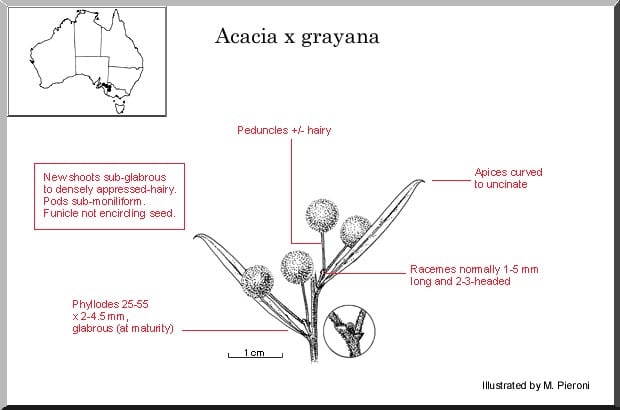Acacia x grayana J.H.Willis
WATTLE
Acacias of Australia
Family
Fabaceae
Distribution
Discontinuous, occurring in the Mannum-Monarto South and Lameroo areas, S.A., and the Wyperfeld Natl Park and Kiata districts, Vic. Grows on sand and sandy loams in mallee or Callitris woodlands.
Description
Dense shrub or tree 2–3 m high. Branchlets glabrous or sometimes appressed-puberulous at the often angled extremities. New shoots subglabrous to densely appressed-puberulous with white or pale golden hairs. Stipules caducous. Phyllodes linear-oblanceolate or narrowly elliptic, 2.5–5.5 cm long, 2–5 mm wide, l:w = 12–21, normally ±abruptly narrowed to a delicate, curved to uncinate point, glabrous, 1-nerved per face, obscurely penninerved. Inflorescences normally 2- or 3-headed racemes; raceme axes normally 1–5 mm long, subglabrous to moderately antrorsely puberulous with white or pale yellow hairs; peduncles 4–12 mm long, with indumentum as on raceme axes; heads globular, 20–35-flowered, bright golden. Flowers 5-merous; sepals free or united. Pods submoniliform, to c. 7 cm long, c. 6 mm wide, thinly coriaceous, glabrous. Seeds longitudinal, elliptic, c. 6 mm long, black; funicle folded on one side of the seed.
Habitat
Grows on sand and sandy loams in mallee or Callitris woodlands.
Specimens
S.A.: northern side of ‘Mount Acres’ property, NE of Lameroo, P.Copley 489 (AD); c. 3 km W of Tepko, K.Czornij 229 (AD). Vic.: WNW of Yarto, just within eastern boundary of Wyperfeld Natl Park, 25 June 1960, I.O.Maroske s.n. (MEL).
Notes
Acacia microcarpa var. linearis J.M.Black was treated by B.R.Maslin, Fl. Australia 11A: 269 (2001), as conspecific with A. × grayana, but this entity is now regarded as a hybrid between A. dictyocarpa and A. euthycarpa.
G.J.Leach & T.Wiffen, Bot. J. Linn. Soc. 76: 53–69 (1978), demonstrated that A. × grayana is a hybrid between A. brachybotrya and A. euthycarpa (the latter species was called A. calamifolia in that publication). Acacia × grayana it is most likely to be confused with the narrowly oblanceolate phyllode forms of A. euthycarpa but is distinguished (rather arbitrarily) by its hairy new shoots and peduncles. These characters also distinguish A. × grayana from A. simmonsiana, which is further distinguished by its narrower pods and terminal, conical aril.
FOA Reference
Data derived from Flora of Australia Volumes 11A (2001), 11B (2001) and 12 (1998), products of ABRS, ©Commonwealth of Australia
Author
B.R.Maslin
This identification key and fact sheets are available as a mobile application:
URL: https://apps.lucidcentral.org/wattle/
© Copyright 2018. All rights reserved.






